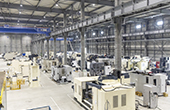When hoses are mentioned, I think of the garden hose I use for watering plants or for washing my car. Unlike those familiar home-use hoses, the world of industrial hoses is varied and dynamic! Hoses are used for myriad purposes—feeding raw concrete at construction sites, discharging slurry in tunnel excavation, feeding liquid nitrogen on fishing boats to flash freeze tuna, to mention a few. Industrial hoses are essential kit in fields of every description.
Our destination is Sumitomo Riko Hosetex in Ayabe City, Kyoto Prefecture, one of the largest plants in Japan for manufacturing industrial hoses. The plant concentrates on two types of industrial hoses: hydraulic hoses and feeder hoses.
Hydraulic hoses are indispensable for fork lifts, excavators, and all sorts of other gear used in construction and civil engineering. Feeder hoses are used for conveying an extraordinary range of materials, everything from concrete and slurry to foodstuffs.
As you can imagine given the multitude of applications, the number of different kinds of hoses is mind-boggling. When I naively asked how many there were, our hosts at Sumitomo Riko Hosetex exchanged bemused glances. “There are so many that we have never actually counted them…” said Mr. Hirokazu Ninagawa, President of Sumitomo Riko Hosetex. “For a start, there are at least 100 kinds of hydraulic hoses just in terms of the combination of the working pressure and the external diameter. Hoses are also classified by applications, such as for construction machinery or industrial equipment, and so there are about 400 to 500 different kinds of hoses. In addition, if you counted the finished products with fittings, the number would rise to tens of thousands or even hundreds of thousands,” continued Mr. Ninagawa.
If you think about it, it’s not such a big surprise. Sumitomo Riko Hosetex is such a powerful contender in the world of industrial hoses because it can exploit Sumitomo Riko Group’s prowess in polymer materials technology for flexible compounding of materials for hoses. More than 10 rubber-based materials are used, such as carbon black for greater strength and oil for flexibility, to achieve the optimum compounding attuned to the customer’s precise needs. The variations are virtually infinite.

 EN
EN
















































